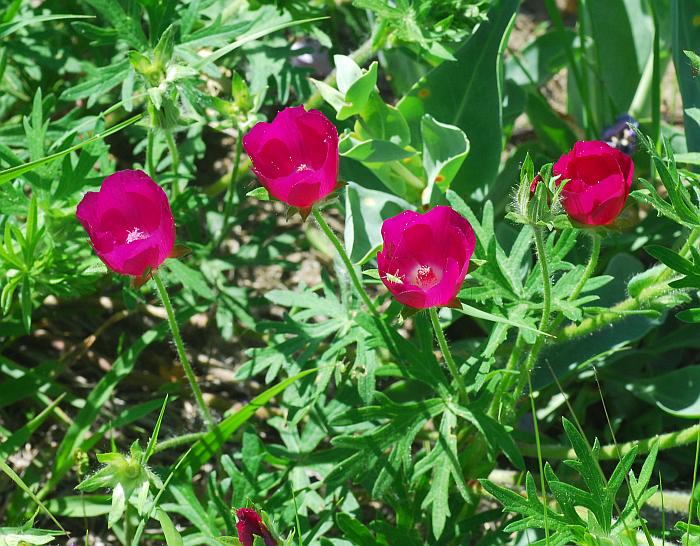Callirhoe involucrata (Torr. & A. Gray) A. Gray
Purple Poppy Mallow

Native
CC = 5
CW = 5
MOC = 21
© SRTurner
Callirhoe involucrata (Torr. & A. Gray) A. GrayPurple Poppy Mallow | |
 |
Native CC = 5 CW = 5 MOC = 21 |
© SRTurner |
|
Family - Malvaceae Habit - Perennial forb from a thickened taproot. Stems - Sprawling or spreading with ascending tips, to 50 cm, densely pubescent with mostly stellate hairs, scabrous.
Leaves - Alternate, petiolate, stipulate. Stipules persistent, auriculate, clasping, to 2 cm long, 2 cm broad, ovate or lanceolate, glabrous, with ciliate margins. Basal leaf petioles 5-9 cm long, pubescent with mostly stellate and sparse simple hairs. Basal leaf blades 2-6 cm long, kidney-shaped to nearly circular in outline, with 3 or 5 deep palmate lobes, these sometimes irregularly lobed again, broad or narrow, the margins entire or sparsely and coarsely toothed, the upper and lower surfaces pubescent with dense 4-rayed stellate and sparse simple hairs. Leaves of the aerial stems with the blades 3-8 cm long, broadly ovate-cordate to obovate in outline, with 3 or 5 deep palmate lobes, these usually pinnately lobed again, the margins entire to sparsely and coarsely toothed, the upper surface pubescent with simple hairs, the lower surface pubescent with stellate and simple hairs.
Inflorescence - Racemes with 4- 10 flowers, these on long peduncles. Peduncles hirsute, to 15 cm. Flowers closely subtended by 3 bractlets, these 8-13 mm long, linear to narrowly ovate or oblanceolate, with hairy margins. Flowers - Calyces 5, 12-19 mm long, the outer surface densely pubescent with simple hairs (these often in irregular fascicles along the strongly raised nerves) and also with 4-rayed stellate hairs, the lobes 8-16 mm long, lanceolate to narrowly lanceolate or less commonly narrowly ovate. Petals 5, 19-33 mm long, pale rose to more commonly wine red or purplish red, often with a lighter area toward the base, glabrous, blunt at apex. Stamen column 1.3 cm long. Filaments deep rose-pink. Anthers pale yellow. Styles 1 cm long, deep rose-pink, at first hidden by stamen column. Ovary of 15-20 carpels in a ring to 5 mm in diameter.
Fruits - Schizocarps 9-12 mm in diameter, with 14-20 mericarps. Mericarps indehiscent, 3.0-4.5 mm long, the dorsal surface glabrous or pubescent with mostly simple hairs, the sides of the fertile portion with a reticulate pattern of thickenings, separated from the inconspicuous beaklike sterile portion but without a well-developed collar. Seeds 2-3 mm long, kidney-shaped, black or less commonly dark brown.
Lookalikes - Callirhoe bushii, other members of the genus. Flowering - May - August. Habitat - Prairies, open woods, roadsides, pastures, railroads. Origin - Native to U.S. Other info. - This is a striking plant with largish flowers of an amazingly rich color. In Missouri it is the most common species of the genus. The plant's main range is to our west, centered in Nebraska through Oklahoma, and in those areas it can be very common. In Missouri it is more scattered. Identification of the Callirhoe genus is trivial, at least for plants in bloom, since nothing else in Missouri has the intensely wine-colored flowers. Differentiation of C. involucrata from other members of the genus can be a bit more challenging. Characters which point to this species are the presence of three bractlets immediately behind the 5-parted calyx, presence of branched hairs on the leaf undersides, and a sprawling (rather than upright) habit. Photographs taken in the Ozark Scenic Riverways, Shannon County, MO., 7-8-03 (DETenaglia); also at Shaw Nature Reserve, Franklin County, MO, 6-8-2007 and 7-1-2013, near Halsey, Thomas County, NE, 6-9-2015, and at Ingalls US-50 rest area, Gray County, KS, 6-4-2016 (SRTurner). |